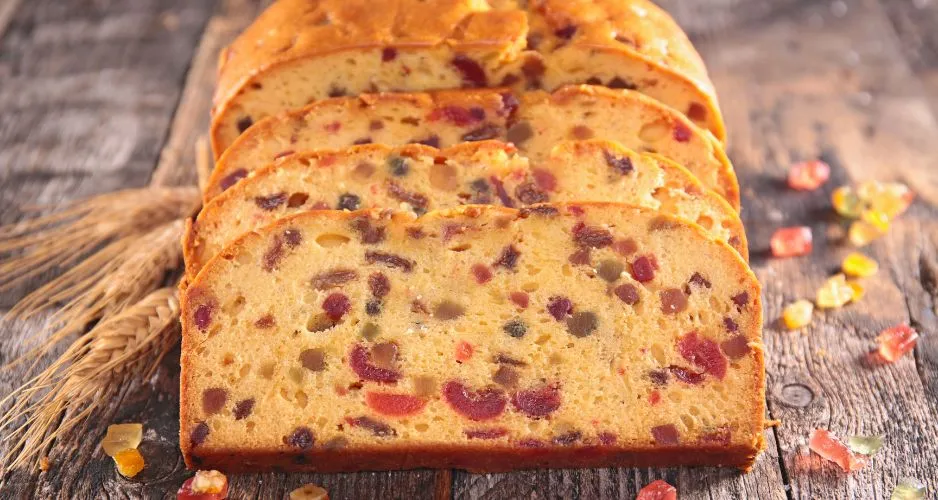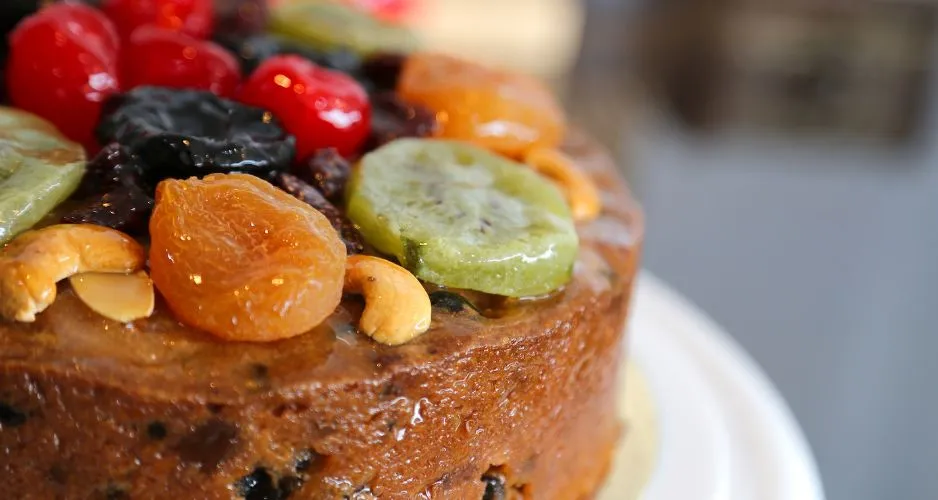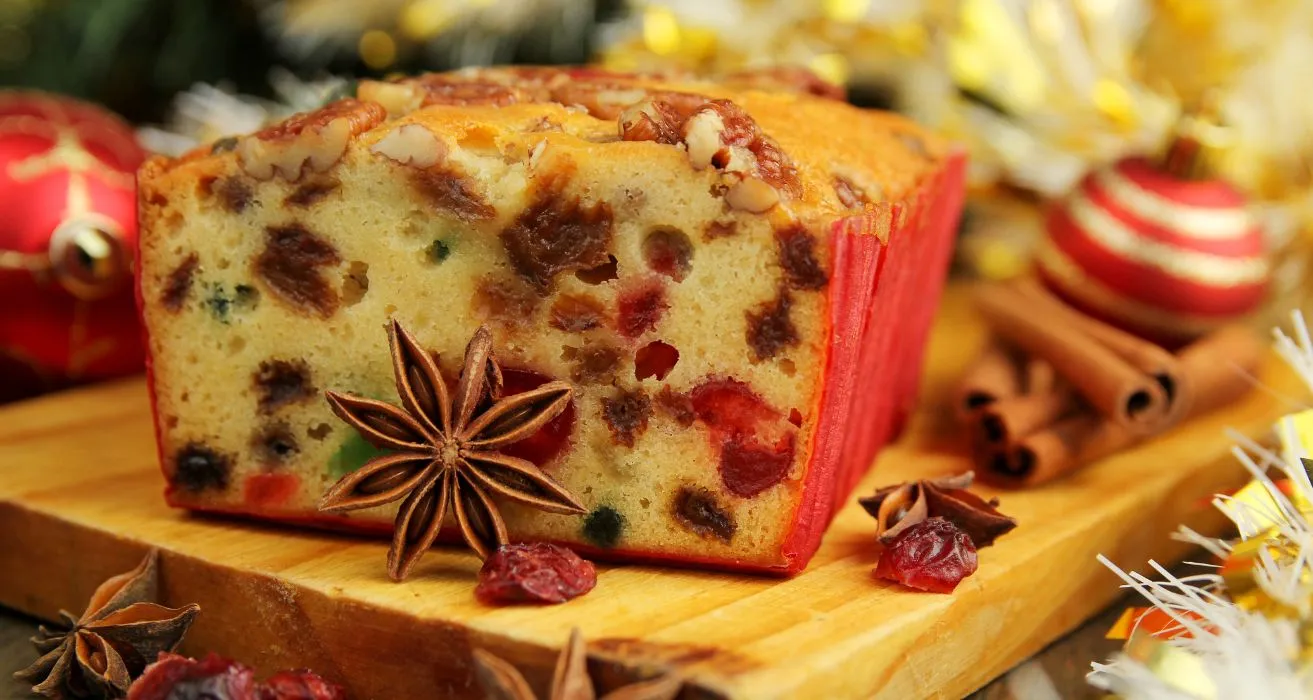Fruit cake: a term that conjures up an array of emotions, from nostalgic warmth to bemused curiosity. Often a staple during holiday seasons, its dense, moist texture and rich flavors have been a subject of many a dinner table discussion. In this article, we’ll dive deep into the world of fruit cakes, exploring its ingredients, variations, cultural significance, and much more. Whether you’re a baking aficionado or simply a curious reader, prepare to have all your fruit cake queries answered.
Introduction
Ah, fruit cake, a dessert that has weaved its way through time, adapting and evolving with each era. Originating from ancient Rome, this dense cake started as a simple mixture of barley mash, pomegranate seeds, nuts, and raisins. Fast forward to the Middle Ages, spices and honey were added to the mix, bringing us closer to the fruit cake we know today.
The transformation didn’t stop there. By the 18th and 19th centuries, fruit cake had become a symbol of wealth and prosperity in Europe. Why, you ask? The ingredients were rare and expensive, making it a luxury item for special occasions. This tradition spilled over to the New World, where it became a Christmas and wedding staple.
But it’s not just about history; it’s about the journey. From an energy-packed snack for Roman soldiers to a festive treat adored across the globe, fruit cake has stood the test of time. Its evolution is a testament to its adaptability and the universal appeal of its rich, fruity goodness.
Common misconceptions about fruit cake
Now, let’s clear the air about some common misconceptions. First off, not all fruit cakes are created equal. Some folks might recall a dense, overly sweet concoction, but that’s just one side of the story. In reality, there’s a whole spectrum of fruit cakes, from light and airy to rich and moist.
Another myth to bust? That fruit cake lasts forever. While it’s true that the alcohol content can preserve these cakes for quite some time, they don’t have an eternal shelf life. Proper storage is key to maintaining their best quality.
In essence, fruit cake is much more than just a holiday dessert. It’s a rich tapestry of history, culture, and culinary artistry, waiting to be appreciated in its full glory. So, grab a fork, and let’s embark on this flavorful journey together. Stay tuned for the next part, where we’ll delve into the ingredients and variations that make fruit cake the beloved treat it is today.
Ingredients and Variations
The Anatomy of Fruit Cake
At its core, fruit cake combines fruits, nuts, and spices with a batter that acts as a delicious glue, holding everything together. The most common ingredients include dried fruits like raisins, cherries, and apricots, alongside nuts such as walnuts or almonds. But the real magic lies in the spices—cinnamon, nutmeg, and allspice—that give fruit cake its distinctive flavor.
Let’s not forget the booze, folks! Brandy, rum, or whiskey are often added to the mix, not just for flavor, but also as preservatives. This little addition is what allows fruit cake to age gracefully, developing deeper flavors over time.

Regional Variations of Fruit Cake Around the World
Now, here’s where it gets interesting. Across the globe, fruit cake wears many delicious hats, adapting to local tastes and traditions.
- In the UK, you’ll find the traditional Christmas cake, a rich, moist fruit cake laden with spices and soaked in alcohol. It’s often covered with marzipan and royal icing, turning it into a festive centerpiece.
- Germany gives us Stollen, a lighter, bread-like fruit cake dusted with powdered sugar and filled with marzipan. It’s a Christmas favorite, embodying the spirit of the holiday season.
- Heading over to the Caribbean, the Black Cake stands out. It’s a denser, darker fruit cake, made unique by its caramelized sugar and a generous amount of rum. This cake is a wedding staple, symbolizing wealth and prosperity.
These variations are just the tip of the iceberg. From Italy’s Panforte to Australia’s boiled fruit cake, each version tells a story of cultural adaptation and culinary creativity.
In this vast world of fruit cakes, there’s a slice for every palate. Whether you prefer yours light and spiced or rich and boozy, the versatility of fruit cake knows no bounds. As we journey through the art of making this beloved dessert, remember, fruit cake is more than just a cake; it’s a celebration of flavors, traditions, and the joy of baking.
Making the Cake
How to Make Fruit Cake
Making a fruit cake begins with choosing your fruits and nuts. Go for a mix of dried fruits like currants, raisins, and cherries, and don’t shy away from experimenting with apricots or dates for a richer flavor profile. Next, toast your choice of nuts for an extra crunch.
Here’s a simplified step-by-step guide:
- Prep your fruits and nuts: Chop if necessary and soak them in your chosen alcohol overnight. This not only hydrates the fruits but also infuses them with flavor.
- Mix the dry ingredients: Combine flour, spices, and a leavening agent to ensure your cake has the perfect rise and flavor.
- Cream the butter and sugar: This step is crucial for a light texture. Add eggs one at a time to emulsify the mixture.
- Combine: Gradually mix the dry ingredients into the creamed butter, then fold in the fruits and nuts.
- Bake slowly: Fruit cake thrives on low and slow baking. This ensures it cooks evenly without drying out.
Remember, patience is key. The low and slow baking method is a test of patience but promises a moist and flavorful outcome.
Customizing Your Fruit Cake
The beauty of fruit cake lies in its versatility. Feel free to swap out ingredients based on dietary preferences or to experiment with flavors. For a non-alcoholic version, use fruit juice or tea as a soaking liquid. Gluten-free? Substitute the regular flour with your preferred gluten-free blend.

For those looking to add a personal touch, consider stirring in a spoonful of orange zest or a dash of your favorite spice. The goal is to make the fruit cake your own, a reflection of your taste and creativity.
As we embrace the rich tapestry of fruit cake traditions and innovations, remember that each cake tells a story. Your fruit cake is not just a dessert; it’s a narrative woven from the ingredients you choose, the care you put in, and the memories it creates.
Cultural Significance
Fruit Cake in Holiday Traditions
Fruit cake is synonymous with celebration, particularly during the Christmas season. Its rich, spiced flavor and dense texture make it a perfect winter treat, embodying the spirit of warmth and generosity. In many households, the making of the fruit cake is a cherished ritual, signaling the start of holiday preparations. This tradition spans continents, from the snowy streets of England to the sunny beaches of the Caribbean.
In the UK, the fruit cake is often adorned with marzipan and royal icing, transforming it into a festive centerpiece. Across the Atlantic, American families treasure their heirloom fruit cake recipes, passing them down through generations. Each slice is a taste of history, a sweet reminder of family ties and shared joy.
Famous Fruit Cake Traditions from Around the World
The universal appeal of fruit cake is evident in its global variations, each reflecting the unique flavors and customs of its region.
- Germany’s Stollen: A lighter, bread-like cake, studded with fruits and marzipan, dusted with powdered sugar to mimic a snowy landscape.
- Italy’s Panettone: A towering, fluffy cake, dotted with candied fruits, embodying the joy and extravagance of Italian Christmas.
- The Caribbean’s Black Cake: A luscious, rum-soaked cake, its dark color and rich flavor a testament to the region’s history and culinary heritage.
These traditions showcase the fruit cake‘s versatility and its ability to bring people together, transcending geographical and cultural boundaries.
Fruit cake is more than just a dessert; it’s a symbol of festivity, prosperity, and the enduring human connection. As we slice into its dense, fruit-filled body, we’re not just indulging in a culinary delight; we’re partaking in a global tapestry of celebration and tradition.
Storage and Preservation
Storing Fruit Cake
The key to fruit cake longevity lies in proper storage. Once baked and cooled, wrap your cake tightly in cheesecloth soaked in your choice of alcohol (for those who prefer a non-alcoholic version, fruit juice works wonders). Then, encase it in aluminum foil or place it in an airtight container. This method not only prevents the cake from drying out but also allows it to absorb the flavors over time, enhancing its richness.
Store your wrapped fruit cake in a cool, dark place. A cupboard or pantry shelf away from direct sunlight is ideal. The cool environment slows down the aging process, while the darkness prevents any light-induced spoilage.
How to Make Fruit Cake Last Longer
For the fruit cake aficionados aiming for an extended maturation period, occasional “feeding” is essential. Every few weeks, unwrap your cake and sprinkle it lightly with alcohol or juice. This not only adds moisture but also enriches the flavor, making each bite a deeper dive into decadence.
Believe it or not, a well-preserved fruit cake can last for months, even up to a year, if stored correctly. It’s a testament to the saying, “Good things come to those who wait.” This longevity makes fruit cake not just a seasonal delight but a year-round treasure, ready to be enjoyed at a moment’s notice.
In wrapping up our discussion on storage and preservation, we’re reminded of the resilience and timelessness of fruit cake. Its ability to stand the test of time parallels the enduring traditions and memories it represents.
FAQs
What are the different types of fruitcake?
There are several types of fruitcake, each with its unique flavors and ingredients. Traditionally, fruitcakes can be categorized into dark, light, moist, and dry varieties. Dark fruitcakes are rich in molasses and brown sugar, packed with dates, prunes, and raisins, offering a deep, complex flavor. Conversely, light fruitcakes are made with light-colored fruits like apricots, golden raisins, and almonds, providing a more delicate taste. Moist fruitcakes, as the name suggests, are known for their succulent texture, achieved by a generous amount of fruit and nuts. Dry fruitcakes, on the other hand, have a firmer texture and less moisture. Additionally, specialty fruitcakes include whiskey-laced, rum-aged, and non-alcoholic versions, catering to diverse palates and preferences.
How alcoholic is fruitcake?
Interestingly, the alcohol content in fruitcake varies significantly depending on the recipe and preparation method. Some fruitcakes are made with liquor-soaked fruits and may be basted with alcohol as they age, which can increase their alcohol content. However, most of the alcohol evaporates during the baking process, leaving the cake with only a residual amount. Consequently, the overall alcoholic content is typically low, but fruitcakes aged with additional alcohol can retain a higher percentage. It’s important to note that the primary purpose of alcohol in fruitcakes is to enhance flavor and preserve the cake, rather than to impart significant alcohol content.
Is fruit cake a healthy food?
While fruitcake contains nutritious ingredients like dried fruits and nuts, which are sources of fiber, vitamins, and minerals, it’s also high in sugar and calories. Therefore, in moderation, fruitcake can be part of a healthy diet, particularly if it’s homemade with adjustments for lower sugar and fat content. However, due to its high-calorie density, it’s best enjoyed in small portions. Furthermore, the nuts in fruitcake provide healthy fats, making it a somewhat nutritious treat when consumed judiciously.
What country is fruit cake from?
Fruitcake has a rich history that spans many countries and cultures. However, its origins can be traced back to ancient Rome, where a rudimentary version was made with pomegranate seeds, pine nuts, and raisins mixed into a barley mash. Over the centuries, the recipe evolved and spread across Europe, with each country adding its twist. By the Middle Ages, fruitcakes had become a popular treat across Europe, featuring spices and preserved fruits. Today, variations of fruitcake are enjoyed worldwide, each reflecting the unique ingredients and tastes of its region.
Why is fruitcake so popular?
Fruitcake’s popularity stems from its rich flavors, dense texture, and the tradition it embodies, especially during the holiday season. Its ability to be made in advance and improve with age makes it a convenient and flavorful option for festive celebrations. Moreover, fruitcake’s versatility allows it to be adapted to various tastes and preferences, making it a beloved treat in many cultures. The tradition of gifting fruitcakes during holidays also contributes to its enduring appeal, symbolizing goodwill and festivity.
What makes it a fruitcake?
What defines a fruitcake is its composition of dried or candied fruits, nuts, spices, and often soaked in spirits. These ingredients are mixed into a batter, creating a dense and moist cake that is both sweet and flavorful. The combination of fruits and nuts can vary widely, allowing for a multitude of variations. Additionally, the process of aging the cake with alcohol not only enhances its flavor but also acts as a preservative, giving fruitcake its distinctive taste and longevity.
Does fruit cake need alcohol?
Alcohol is not a necessity for fruitcake, but it is commonly used for flavoring and preservation. There are plenty of non-alcoholic versions that rely on fruit juices or syrups to moisten the cake and enhance its flavor. For those who prefer to avoid alcohol, using apple juice or concentrated orange juice as a substitute can still result in a delicious and moist fruitcake. Therefore, while traditional recipes often include alcohol, it’s entirely possible to make a delectable fruitcake without it.
Does fruitcake expire?
Fruitcake is renowned for its long shelf life, thanks to the preservative qualities of alcohol and sugar. When stored properly in a cool, dry place, and particularly if it is periodically moistened with alcohol, a fruitcake can last for months or even years without spoiling. However, non-alcoholic fruitcakes have a shorter shelf life and should be consumed more quickly or kept refrigerated to extend their freshness. Regardless, it’s essential to check for signs of spoilage, such as mold or off odors, before consumption.
Why do fruitcakes last so long?
The longevity of fruitcakes is attributed to their high sugar and alcohol content, both of which are natural preservatives. The drying process of the fruits also contributes to the cake’s shelf life by reducing moisture, which can lead to spoilage. When properly stored and sealed, these factors combined allow fruitcakes to last an impressively long time, making them ideal for aging and enjoying over extended periods. This durability is part of what makes fruitcake a traditional gift for special occasions and holidays.
Is there a fruitcake that tastes good?
Yes, many fruitcake varieties are delicious, contrary to the common stereotype of fruitcake being unpalatable. The key to a tasty fruitcake lies in the quality of ingredients, the balance of flavors, and the preparation method. A well-made fruitcake can offer a delightful blend of sweet, spicy, and nutty flavors, with a moist texture that enhances its taste. Exploring different recipes and finding one that suits your taste preferences can lead to discovering a fruitcake that not only tastes good but becomes a favored treat.
Why is fruit cake so dense?
The density of a fruit cake comes from its rich combination of dried fruits, nuts, and alcohol (or juice). These ingredients, when mixed into the batter, create a tightly packed, moist texture that is characteristic of the cake. The density is not just about the cake’s structure; it’s a hallmark of its flavor-packed bites.
Can fruit cake go bad?
While fruit cake is known for its impressive shelf life, especially when properly stored, it can go bad if exposed to air or moisture, leading to mold growth. To prevent this, ensure your cake is tightly wrapped and stored in a cool, dry place. Regular “feeding” with alcohol or juice can also help extend its life.
How to moisten a dry fruit cake?
If your fruit cake has turned dry, fear not. You can rejuvenate it by wrapping it in a damp cloth, then tightly in foil, and gently warming it in a low oven. Afterward, sprinkle it with alcohol or juice to reintroduce moisture. This process can help revive the cake, bringing back its moist, dense texture.
Is fruit cake healthy?
Fruit cake can be part of a balanced diet in moderation. It’s packed with fruits and nuts, which provide nutrients and fiber. However, due to its sugar and alcohol content, it’s best enjoyed in small portions. For a healthier version, consider using less sugar and more natural sweeteners like honey or dates.
In dispelling these myths and answering these questions, we hope to have enriched your understanding and appreciation of fruit cake. This cake is not just a holiday staple but a canvas for creativity, a symbol of celebration, and a link to culinary traditions around the world.
Conclusion
Our exploration of fruit cake has revealed its complexity and versatility. We’ve seen how it transcends cultures and traditions, bringing people together in celebration and festivity. Whether enjoyed as a dense, boozy delight or a lighter, spiced confection, fruit cake holds a place in the hearts and traditions of many around the globe.
The key takeaway from our journey? Don’t be afraid to embrace fruit cake, with all its quirks and flavors. Whether you’re baking it from scratch, customizing it to suit your taste, or simply savoring a slice handed down from generations, remember that each bite carries the essence of celebration, history, and craftsmanship.
As we part ways with our fruit cake narrative, let’s carry forward the spirit of experimentation and tradition that this cake embodies. May your baking adventures be fruitful, and your celebrations filled with the richness and warmth of this timeless treat.
